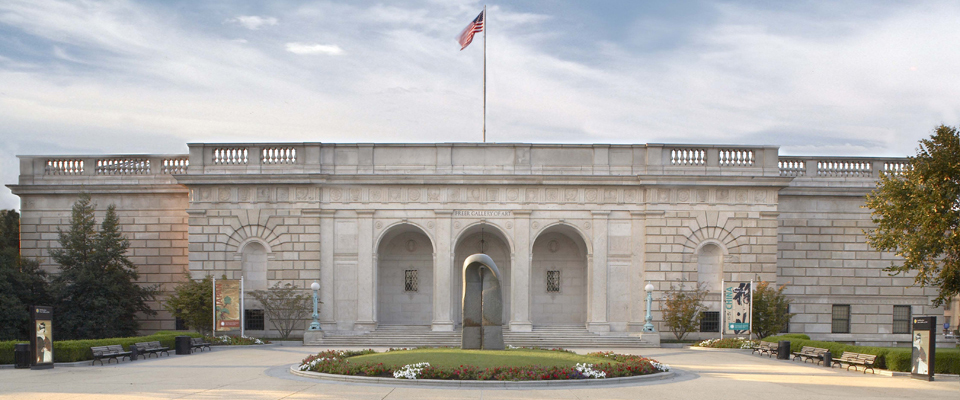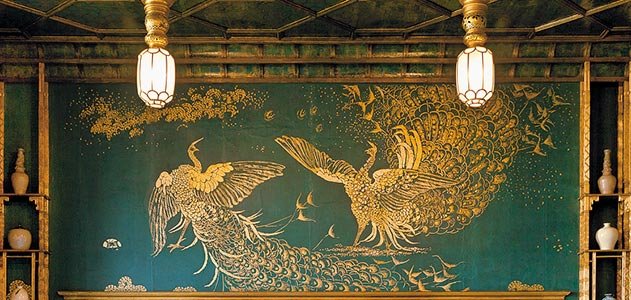|

The Freer Gallery, Washington DC
Foreword: Back in the day, when I was travelling around the world imparting the values and knowledge of effective project management, I would occasionally find myself teaching in Washington, DC where the company I most worked for had a suite of classrooms in the Watergate complex. Students would often ask what there was to see in DC aside from the obvious. I always recommended the Peacock Room at the Freer Gallery, and gave an overview of why I found it interesting. Here is a fuller version of that overview.
In 1876, the Peacock Room was commissioned by Frederick R. Leyland, a British Shipping Magnate, for his home at 49 Prince’s Gate in the Kensington section of London. Its interior walls and ceiling were of antique leather, stretched over a wooden frame. Finished in 1877, it served not only as a dining room but also as a display room for Leyland’s collection of blue and white Chinese porcelain ware. Leyland died in 1892. In 1894, the room-within-a-room framework and leather was purchased by a London art gallery and reconstructed there. In 1904, it was purchased by Charles Freer, an American collector of Asian art, and again reconstructed in his Detroit mansion. Upon Freer’s death, it was part of a large collection of Asian art donated, along with funds for construction, to be housed in a new Freer Gallery of Art on the Mall in Washington, DC. This opened in 1923.
If you stand on the Washington Mall facing south toward the red sandstone Smithsonian Building, you see just behind it and to the right the Freer and Sackler Gallery of Asian Art. The Peacock Room sits in the southeast corner of the main floor of the building. I like this room not only for its art, but for its quirky history.
Back in 1876, Frederick Leyland placed architect Richard Norman Shaw in overall charge of remodeling and redecorating his house. But Leyland had something special in mind for the dining room. He wanted to use it to exhibit his extensive collection of Chinese porcelain, and thus needed a lot of shelving. Shaw subcontracted the remodeling of the dining room of the shelving and wall coloring, etc. to Thomas Jeckyll, an architect experienced in the Anglo-Japanese style.
This vector of remodeling activity met another vector that had been underway for some time. It was spearheaded by James McNeill Whistler. Whistler had come to London in the late 1850’s to study art. He didn’t exactly set London afire, so he decamped to study in France. Here he and many others were influenced by the art of Japan, as represented by Japanese ukiyo-e prints arriving in the West, and incorporated that influence into his work.
Returning to London, he received a much better reception than before, since there was an Anglo-Japanese movement afoot there as well. Leyland and his wife became patrons of his art, and Leyland had him execute a portrait of his wife in the oriental fashion. Since it was intended to hang in the future dining/porcelain display room, it was called Rose and Silver: The Princess from the Land of Porcelain. Leyland envisioned a matching portrait of himself on the opposing wall.

For the walls of his dining room, Leyland purchased antique leather that had hung on the walls of a Norfolk estate for 1,000 pounds. It had once been part of the dowry of Catherine of Aragon for her marriage to Henry VIII. Catherine’s father, the King of Spain, had acquired the antique leather (dating from the 6th century) and had it embossed with red Tudor roses and her heraldic device, the open pomegranate, to signify their union. Jeckyll had it stretched over the afore-mentioned framework in the dining/display room. The work was progressing nicely and almost finished when Jeckyll consulted Whistler about what color to use on the shutters and doors of the room. Whistler had a separate commission to the decorations for the entrance hall. (There is some speculation that the reason for this was that Whistler and Frances were an item. It is known that after the events to follow she separated from her husband.)
Shortly after this consultation, Jeckyll took sick, and Whistler took over.
One thing he immediately recommended was overpainting the red roses with touches of yellow to better integrated with Frances’s portrait. He also suggested adding a wave pattern in gilt along the wainscot and cornices. Leyland agreed, and then had to leave for some months to attend to his shipping business in Liverpool.
Whistler was neither shy about expressing his opinions, nor was he lacking in ego. (He had adopted as his symbol a butterfly with a stinger—the butterfly evoked the sensitivity of his art and the stinger reflected his interactions with the public at large.) In his patron's absence, Whistler was inspired to make bolder revisions. He determined the dark brown leather color just wouldn’t do as a backdrop for blue and white porcelain. He therefore proceeded to paint over the antique leather in sea green, including the inside of the walnut shutters over the three tall windows overlooking the park. He also covered the ceiling with “Dutch metal”, or imitation gold leaf, over which he painted a lush pattern of peacock feathers. He then gilded Jeckyll's walnut shelving and embellished the wooden shutters with four magnificently plumed peacocks.
Whistler wrote to Leyland that the dining room was "really alive with beauty — brilliant and gorgeous while at the same time delicate and refined to the last degree," boasting that the changes he had made were past imagining. "I assure you," he said, "you can have no more idea of the ensemble in its perfection gathered from what you last saw on the walls than you could have of a complete opera judging from a third finger exercise!" He urged Leyland not to return to London yet, since he did not want the room to be seen before every detail was perfect.


Yet Whistler entertained visitors and amused the press in the lavishly decorated room, never thinking to ask permission of the owner of the house. When Leyland returned what he found left him shocked and angry.
Whistler’s audacious behavior, coupled with a dispute over payment for the project, provoked a bitter quarrel between artist and patron. Leyland would not consent to pay the two thousand guineas that Whistler wanted, an immense sum. "I do not think you should have involved me in such a large expenditure without previously telling me of it," he wrote to the artist. Eventually Leyland agreed to half that amount, but further insulted Whistler by writing his check in pounds, the currency of trade, when payment to artists and professionals was customarily made in guineas. (A pound is worth twenty shillings and a guinea twenty-one, so the already offensive sum was also smaller than expected.)
Perhaps in retaliation, Whistler painted a pair of peacocks aggressively confronting each other on the end wall opposite The Princess in the Land of Porcelain. He used two shades of gold for the design and highlighted telling details in silver. Scattered at the feet of the angry bird are the coins (silver shillings) that Leyland refused to pay; the silver feathers on the peacock's throat allude to the ruffled shirts that Leyland always wore. The poor and affronted peacock has a silver crest feather that resembles the lock of white hair that curled above Whistler's forehead.

To drive his point home, Whistler named the mural "Art and Money; or, The Story of the Room." He obtained a blue rug to complete the scheme and titled the room Harmony in Blue and Gold. After concluding his work in March 1877, the artist never saw the Peacock Room again.
Altogether, the room makes for a “must-see” for art and history lovers.
|